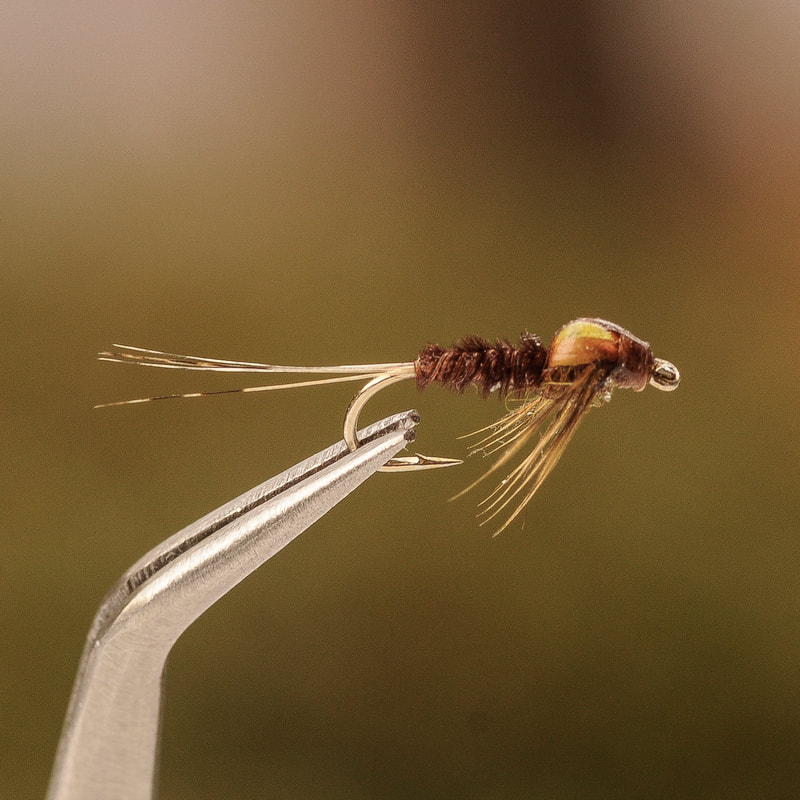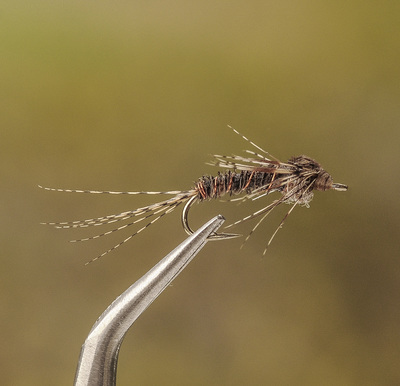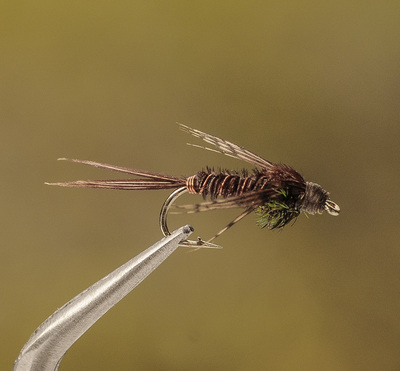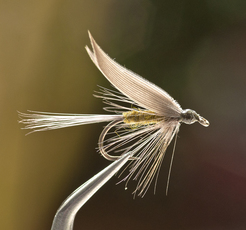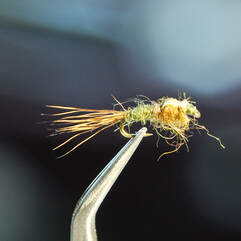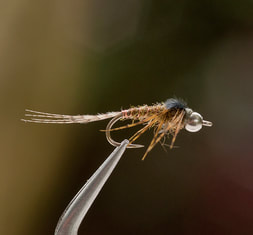Fly of the Month 05.2015
We continue with Part Two of Blue Wing Olive (BWO). Our general research indicates that the nymph stage of the BWO is very important during the winter months. BWOs uniquely hatch on any given day that is cloudy, overcast, drizzly or even during intermittent rain, especially early in the morning and later in the afternoon. In addition to trout feeding heavily on nymphs, Part Two will address two other BWO situations occurring underwater, emergers just below the surface and submerging female egg-laying adults making sure their eggs are attached to the bottom structures.
Blue Wing Olive – Part Two – Nymphs
Recall “Pheasant Tail Nymphs or a Gold-Ribbed Hares Ear work as imitations of the BWO. (You should) dead-drift the fly in the water just downstream from a riffle. Which brings us back to positively rheotactic which, rather than an exclamation, is a term used by entomologists to describe how riffle species generally orient head first into the current.” says Tim Wilhelm in his article in October 2011.
Since BWO nymphs are bottom crawlers, a bead head, olive version of the pheasant tail or hares ear may be more effective for general use or a Bead Head Baetis Nymph (which is olive) is a much closer imitation for getting down to specifically determining if the trout are truly bottom feeding on BWO nymphs.
If the trout appear to be “bulging” which is feeding just under the surface without actually rising, a BWO emerger may be the very fly pattern required. If this does not work, try the fly patterns covered in Part One (refer to Fly of the Month 3.15).
Recall “…the egg-laying female crawls below the surface to lay eggs and are often knocked loose. When nothing else appears to be working (you should) try a soft hackle (or wet fly which) works well here. Put a small shot on the leader and cast upstream, giving the fly time to reach the bottom. Then jig the rod to give the fly some action.” says Tim Wilhelm in his article in October 2011.
The key here is to leverage the current in the riffle. Position yourself to one side and upstream of the riffle and fly fish downstream with a soft hackle or wet fly. The trout sense no leader as they can only see what appears to be a female BWO maneuvering in the current to get to a rock to lay eggs. Fool’em with the natural action of the riffle current in their face!
We provide three (4) recipes for below surface fly presentations of the Blue Wing Olive.
Flies of the Month 3.15
BWO Nymph (refer to Fly of the Month 10.11)
Bead Head Baetis Nymph
BWO CDC Emerger (refer to Fly of the Month 10.11)
BWO Para Emerger
Center-Beaded Partridge and Olive Soft Hackle (with egg sac)
Olive Dun Wet Fly (Bergman, Ray. Trout, Plate No. 6, recipe on page 485)
Bead Head Baetis Nymph
Hook: Tiemco 200R or equivalent, size 14,16,18,20,22
Thread : Uni 8/0 Olive
Bead: Tungsten or brass to match hook size in silver or black
Tail : Lemon Wood Duck Flank feather
Body : Brown Olive Spectrablend dubbing with copper wire
Legs : Hungarian Partridge dyed olive
Wing Case: Black Marabou
Directions :
- Tom Adams, Alen Baker
We continue with Part Two of Blue Wing Olive (BWO). Our general research indicates that the nymph stage of the BWO is very important during the winter months. BWOs uniquely hatch on any given day that is cloudy, overcast, drizzly or even during intermittent rain, especially early in the morning and later in the afternoon. In addition to trout feeding heavily on nymphs, Part Two will address two other BWO situations occurring underwater, emergers just below the surface and submerging female egg-laying adults making sure their eggs are attached to the bottom structures.
Blue Wing Olive – Part Two – Nymphs
Recall “Pheasant Tail Nymphs or a Gold-Ribbed Hares Ear work as imitations of the BWO. (You should) dead-drift the fly in the water just downstream from a riffle. Which brings us back to positively rheotactic which, rather than an exclamation, is a term used by entomologists to describe how riffle species generally orient head first into the current.” says Tim Wilhelm in his article in October 2011.
Since BWO nymphs are bottom crawlers, a bead head, olive version of the pheasant tail or hares ear may be more effective for general use or a Bead Head Baetis Nymph (which is olive) is a much closer imitation for getting down to specifically determining if the trout are truly bottom feeding on BWO nymphs.
If the trout appear to be “bulging” which is feeding just under the surface without actually rising, a BWO emerger may be the very fly pattern required. If this does not work, try the fly patterns covered in Part One (refer to Fly of the Month 3.15).
Recall “…the egg-laying female crawls below the surface to lay eggs and are often knocked loose. When nothing else appears to be working (you should) try a soft hackle (or wet fly which) works well here. Put a small shot on the leader and cast upstream, giving the fly time to reach the bottom. Then jig the rod to give the fly some action.” says Tim Wilhelm in his article in October 2011.
The key here is to leverage the current in the riffle. Position yourself to one side and upstream of the riffle and fly fish downstream with a soft hackle or wet fly. The trout sense no leader as they can only see what appears to be a female BWO maneuvering in the current to get to a rock to lay eggs. Fool’em with the natural action of the riffle current in their face!
We provide three (4) recipes for below surface fly presentations of the Blue Wing Olive.
Flies of the Month 3.15
BWO Nymph (refer to Fly of the Month 10.11)
Bead Head Baetis Nymph
BWO CDC Emerger (refer to Fly of the Month 10.11)
BWO Para Emerger
Center-Beaded Partridge and Olive Soft Hackle (with egg sac)
Olive Dun Wet Fly (Bergman, Ray. Trout, Plate No. 6, recipe on page 485)
Bead Head Baetis Nymph
Hook: Tiemco 200R or equivalent, size 14,16,18,20,22
Thread : Uni 8/0 Olive
Bead: Tungsten or brass to match hook size in silver or black
Tail : Lemon Wood Duck Flank feather
Body : Brown Olive Spectrablend dubbing with copper wire
Legs : Hungarian Partridge dyed olive
Wing Case: Black Marabou
Directions :
- Debarb the hook, add the bead and then wrap the thread in tight, single, touching wraps starting at the thread at the bead and stopping at the hook barb. Return the thread in open wraps to the bead head. Let the bobbin hang.
- Select a three inch section of fine copper wire and tie in on the side of the hook shank facing you. Insert the wire in the gap of the bead head and the hook to begin the tie in. Wrap the thread in firm wraps to the hook barb. Make two wraps of thread immediately behind and tight to the wire finishing with a single wrap in from of the wire and let the bobbin hang. It will aid in the first wrap of the wire if you will, gently, pull the wire to a right angle from the hook shank and make a false, half wrap. This will position the wire in the best manner for that first wrap.
- Select a lemon wood duck feather and strip away the webby barbs. Choose four or so barbs and holding by the tips (to align the tips), strip away from the stem. You will notice the barbs have a natural curve. Tie in on top of the hook shank with the curve up. Use the thread, which is tight and forward of the wire tie in, but touching the wire tie in, for a single wrap over the wood duck to trap them in place and then make two securing wraps with the copper wire while maintaining the wood duck on top of the hook shank. The first wrap of wire is soft to avoid pushing the wood duck off the top of the hook shank and the second wrap is much firmer. Position the wire out of the way for wrapping later.
- Lightly wax the thread and apply a small amount of dubbing to form a noodle. Remember the abdomen of BWO’s is pretty small, so keep the dubbing to a minimum. Dub in tight, touching turns to the thorax and let the bobbin hang.
- Begin wrapping the copper wire forward in four or five, open and evenly spaced turns. Secure the wire with two three wraps behind and one in front and a final one turn behind. Break off the wrap by “helicoptering” the wire and make one or two wraps of thread to cover and smooth the wire end. Return the thread to the end of the thorax and let the bobbin hang.
- Select a black marabou feather and stroke away the webby fibers. Select sufficient fibers to form a wing case from the center of the feather. Align the tips and moisten for control, tying in on top of the hook shank immediately in front of the abdomen. Let the bobbin hang.
- Dub a small, tight noodle of the brown olive dub and begin wrapping the dub at the bead advancing to the abdomen. Let the bobbin hang.
- Select a partridge feather for the legs. The brown feathers from the lower, center of the back are best. Pinch the tip of the feather and stroke back the remaining fibers. Tie in with one or two wraps, holding the partridge with the curved face up, by the tip immediately in front of the abdomen and marabou. Dub the thread with a wisp of dub (just to barely cover the thread) and advance the thread to the bead. Gently pull the partridge forward, over the dubbing and stoke back three or four fibers to make the legs. Wiggle the thread through the partridge to trap the feather with the legs in the back and the waste in the front. One or two wraps are sufficient. Let the bobbin hang.
- Pull the marabou forward, further trapping the legs and forming the wing case. Trap both marabou and partridge at the bead head with several wraps. Trim the marabou and partridge tight to the bead and whip finish to complete the fly.
- Tom Adams, Alen Baker

